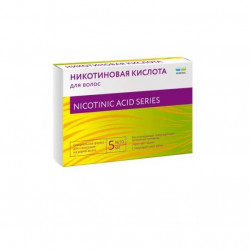



 All payments are encrypted via SSL
All payments are encrypted via SSL
 Full Refund if you haven't received your order
Full Refund if you haven't received your order
a nicotinic acid.
injection.
1 ml of solution contains:
active ingredient: nicotinic acid - 10 mg,
excipients: sodium bicarbonate, water for injection.
Transparent colorless liquid.
vitamin.
Nicotinic acid is a specific anti-pulmonary agent. It has a pronounced short-term vasodilating effect, improves carbohydrate and nitrogen metabolism, has hypolipidemic activity, lowers total cholesterol, low-density lipoprotein, and improves microcirculation.
In the body, nicotinic acid is converted to nicotinamide, which is associated with the coenzymes of codehydrogen I and II (NAD and NADP), transferring hydrogen, is involved in the metabolism of fats, proteins, amino acids, purines, tissue respiration, glycogenolysis, and synthetic processes. Fills the deficiency of vitamin PP (vitamin B3), is a specific anti-pellag remedy (vitamin PP vitamin deficiency).
Normalizes blood lipoprotein concentration.
It has a vasodilating effect at the level of small vessels (including the brain), improves microcirculation, has a weak anticoagulant effect (increases the blood fibrinolytic activity).
When administered parenterally, it is rapidly distributed in body tissues. In the body is transformed into nicotinamide. It accumulates mainly in the liver, as well as in adipose tissue and kidneys. In the liver, nicotinic acid is converted to an amine, which is incorporated into nicotinamide adenine dinucleotide (NAD), which is a prosthetic group of enzymes that carry hydrogen and carry out redox processes.
Metabolized in the liver. The major metabolites, N-methyl-2-pyridone-3-carboxamide and N-methyl-2-pyridone-5-carboxamide, do not possess pharmacological activity.
It can be synthesized in the intestine by bacterial flora from tryptophan from food (from 60 mg of tryptophan 1 mg of nicotinic acid is formed) with the participation of Pyridoxine (vitamin B6) and riboflavin (vitamin B12). The half-life is 45 minutes.
Excreted by the kidneys in the form of metabolites, when taking high doses - mostly unchanged. Renal clearance depends on the level of nicotinic acid in the blood plasma and may decrease at a high concentration in the plasma.
Hypovitaminosis of PP, avitaminosis of PP (pellagra). Ischemic disorders of cerebral circulation, obliterating vascular diseases of the extremities (obliterating endarteritis, Raynaud's disease), vasospasm of the extremities, bile and urinary tract, neuritis of the facial nerve. Diabetes mellitus, including its complications (diabetic polyneuropathy, microangiopathy. Hartnup disease (hereditary disease, accompanied by a violation of the absorption of certain amino acids, including tryptophan).
Hypersensitivity, severe arterial hypertension, atherosclerosis, gout, hyperuricemia, childhood. Pregnancy, lactation.
Hemorrhages, glaucoma, liver failure, arterial hypotension, hyperacid gastritis, peptic ulcer and 12 duodenal ulcer (in the acute stage).
In case of pellagra, adults are prescribed parenterally (subcutaneously, intramuscularly, intravenously (slowly) - 10 mg (1% solution in 1 ml) 2-3 times a day, for 10-15 days.) In ischemic stroke, 10 mg solution is slowly administered intravenously.
For other indications - 10 mg 1-2 times a day, for 10-15 days. Higher doses for adults: single - 0.1 g, daily - 0.3 g
Hartnup disease 40-200 mg per day.
Allergic reactions (skin rash, pruritus, wheezing, urticaria).
After intravenous rapid injection: orthostatic hypotension, collapse.
Hyperemia of the skin of the face and upper half of the body, paresthesia, dizziness, "tides" of blood to the skin of the face, headache, dizziness.
Local reactions: pain in places of subcutaneous and intramuscular administration.
High doses of nicotinic acid can cause a temporary rush of blood to the head and upper torso, itching, and gastrointestinal disturbances.Treatment: symptomatic.
When combined with sulfonylurea drugs may increase blood glucose levels.
Care must be taken when combining with antihypertensive drugs, anticoagulants and Ascorbic acid.
It reduces the toxicity of neomycin and prevents them from reducing the concentration of cholesterol and high-density lipoprotein.
In the process of treatment it is necessary to control the function of the liver.
To prevent complications from the liver, it is recommended to include products rich in methionine (cottage cheese) in the diet, or to use methionine, Lipoic acid and other lipotropic drugs.
Taking into account the injection route of administration of the drug, side effects, there is no need for use during pregnancy.
Solution for injection 10 mg / ml.
On 1 ml in ampoules of neutral glass or in ampoules polymeric from high-density polyethylene, or from low-pressure polyethylene, or from polyethylene for medical purposes, or from polyethylene or polypropylene for infusion solutions and injectables.
On the ampoule stick labels.
On 10 ampoules of neutral glass with the instruction for application are placed in a box from a cardboard with a corrugated insert from paper.
In each box they put an ampoule knife or a scarifier.
When packaging ampoules with notches, rings and dots, ampoule knives or scarifiers do not insert.
A box pasted over the label-parcel post.
On 10 ampoules polymeric with the instruction for application are placed in a pack from a cardboard.
List B. In the dark place at a temperature of no higher than 25 ° C.
Keep out of the reach of children.
5 years.
Do not use after the expiration date printed on the package.
